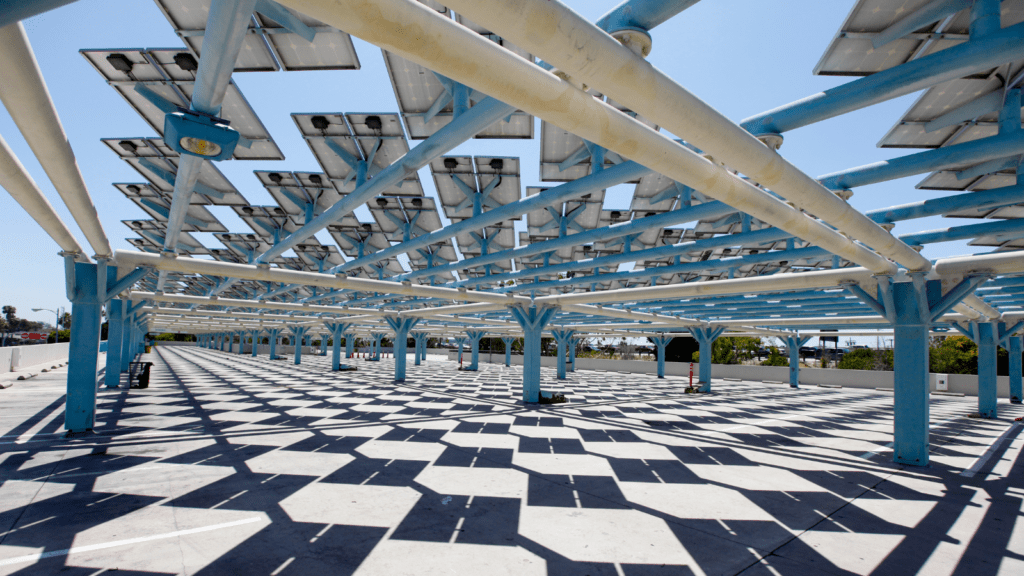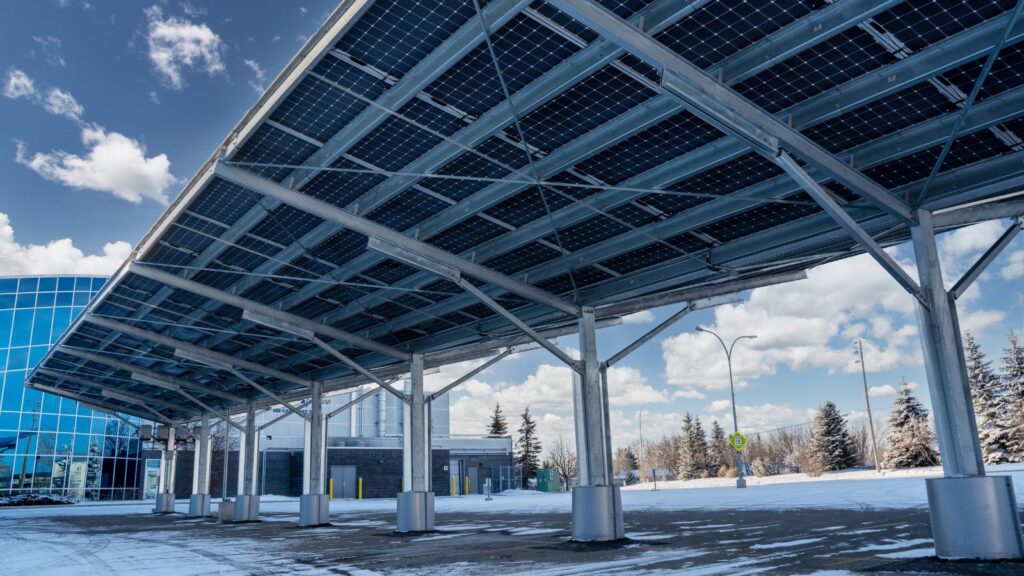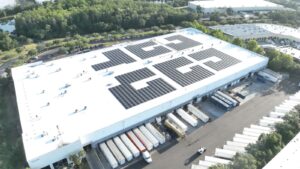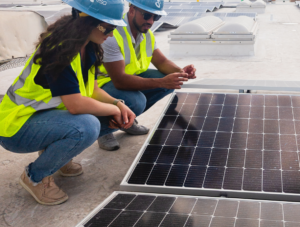Solar carport structures are a game-changing solution that combines the benefits of solar panels with the practicality of covered parking, offering an innovative way to utilize existing spaces while reaping long-term savings. Let’s explore the ins and outs of solar carport structures, their benefits, costs, and how to choose the right design and installation partner.
Key Takeaways
- Solar carports are dual-purpose structures that provide shade for parked vehicles while generating electricity through photovoltaic panels.
- Solar carports offer numerous advantages, such as effective utilization of space and increased protection for vehicles, while also reducing greenhouse gas emissions by generating clean energy.
- Incentives and tax credits can significantly reduce the cost of solar carport installations, making them an attractive investment in green technology.
Understanding Solar Carport Structures
Referred to as solar canopies sometimes, solar carports serve a dual purpose: providing shade for parked vehicles while generating electricity through their photovoltaic panels. This means that while your car stays cool and protected from the harsh Florida sun, the solar panels are hard at work converting sunlight into electrical energy.
Solar carports operate similarly to ground-mounted photovoltaic (PV) systems, with the racking structure attached to the ground. The solar capacity of a carport depends on the number and efficiency of the solar panels installed.
What sets solar carports apart from traditional solar installations is that they stand alone and serve as a shelter for vehicles while producing energy. Designing and installing solar carports require both electrical and computer engineering expertise to ensure optimal performance and safety.
Essentially, solar carports, alternatively called solar parking structures, creatively optimize parking availability while promoting a cleaner and more sustainable future.

Components of a Solar Carport System
A typical solar carport system consists of several key components:
- Supporting structure: This creates a solar-covered parking lot for vehicles.
- Solar panels: These capture and convert sunlight into electrical energy to offset energy costs.
- Mounting system: This securely holds the solar panels in place.
- Tilt angles: These are adjustable to optimize the angle at which the solar panels receive sunlight.
- Waterproofing components: These ensure that the carport system is protected from water damage.
The components of a solar carport system include:
- The mounting system, which securely fixes the solar panels to the supporting structure and allows for the adjustment of tilt angles to optimize sunlight capture.
- Waterproofing components, which protect the solar carport system from the elements.
- Solar panels, which generate electricity from sunlight.
Solar carports, often used for charging electric vehicles, are smaller-scale versions of solar farms, generating renewable energy in a more localized setting, with solar power generated efficiently.
How Solar Carports Generate Electricity
The process of generating electricity with solar carports is simple: photovoltaic panels transform sunlight into electrical energy. A solar carport system usually consists of photovoltaic panels, mounting structures, and an inverter.
By doing so, solar carports offer efficient utilization of space, improved vehicle protection, and comfort, and help attract environmentally conscious customers.
The initial investment and installation costs can be offset by long-term savings and benefits, as well as any applicable incentives and tax credits.
Advantages of Solar Carport Installations
Given the abundance of parking spaces, solar carports hold substantial potential in the United States. They offer numerous advantages, such as effective utilization of space, increased protection and comfort for vehicles, and the ability to draw in environmentally conscious customers.
In addition to these benefits, solar carports can also contribute to a greener future by generating clean energy and reducing greenhouse gas emissions.
Efficient Use of Space
Solar carports utilize existing parking areas, optimizing space and eliminating the need for extra land. This means that businesses and homeowners can save money and resources by installing solar carports in their parking lots instead of seeking additional land for solar panel installations.
This efficient use of space is one of the main advantages of solar carports, making them an attractive option for those looking to maximize the benefits of their property.
Enhanced Vehicle Protection and Comfort
Providing shade and cooler temperatures for parked vehicles is one of the most notable benefits of solar carports. By protecting vehicles from the harsh sun, solar carports can help reduce fuel consumption and wear on vehicle components, such as paint and upholstery.
Furthermore, solar carports can provide natural cooling for parked vehicles, reducing the demand for air conditioning and, in turn, lowering energy costs.
In addition to the protective aspects, solar carports also offer improved vehicle security and the potential for electric vehicle (EV) charging capabilities. By providing a well-lit and secure parking area, solar carports can increase customer satisfaction and attract eco-conscious clientele, further enhancing the appeal of businesses that choose to invest in this green technology.
Attracting Eco-Conscious Customers
Demonstrating a commitment to sustainability and environmental responsibility, businesses can attract environmentally conscious customers and enhance their green reputation by installing solar carports.
Solar carports can offer businesses increased energy efficiency, reduced energy costs, and a more favorable green reputation.
Well-known companies like Walmart, Target, and Costco have already implemented solar carports, showcasing their commitment to sustainable practices and setting an example for others to follow.

Assessing the Costs and Savings of Solar Carports
Although solar carports require an initial investment, they also yield long-term savings, benefits, and potential incentives. However, the additional costs can be offset by the numerous advantages and long-term savings that solar carports provide.
Long-term Savings and Benefits
In the form of decreased energy costs, reduced maintenance expenses, and increased property value, solar carports can yield long-term savings. By providing shade for vehicles and generating clean energy, solar carports can help lower energy bills and reduce the demand for air conditioning.
As a result, businesses and homeowners can save money on energy costs over time, making the initial investment in a solar carport more than worthwhile.
In addition to the financial savings, solar carports offer other long-term benefits such as increased vehicle protection and comfort, and the potential to attract environmentally conscious customers. These benefits can further enhance the value of your property and contribute to a greener, more sustainable future.
Incentives and Tax Credits
Incentives and tax credits are available to help offset the cost of solar carport installations. The federal solar tax credit, for example, is a 30% tax credit available for all solar projects, including solar carports, as per IRS guidelines.
By taking advantage of these incentives and tax credits, the overall cost of solar carport installations can be significantly reduced, making them an even more attractive investment.

Solar Carport Applications
Commercial and Industrial Buildings
Commercial and industrial settings can greatly benefit from solar carports by generating clean energy, reducing energy costs, and providing shaded parking for employees and customers.
Solar carports can optimize limited real estate, serve as a sustainable energy source for businesses, and even act as a distinguishing feature that sets the company apart from competitors.
This makes solar carports an attractive option for businesses looking to invest in green technology.
Educational and Community Institutions
Educational and community institutions can also utilize solar carports to generate clean energy, reduce energy costs, and provide shaded parking for students, staff, and visitors. In addition to these practical benefits, solar carports can create learning opportunities for students, promote sustainability initiatives, and potentially save low-income schools tons of money.
Choosing the Right Solar Carport Design
For a successful project, selecting the right solar carport design and installation partner is crucial. Factors to consider when choosing a design include the location, available sunlight, and desired aesthetics of the structure.
Factors to Consider in Solar Carport Design
Location, available sunlight, and desired aesthetics of the structure should be taken into consideration when designing a solar carport. These factors will affect the efficiency of the solar panels, the overall look of the carport, and the satisfaction of the end-users.
By carefully evaluating these factors, you can ensure that your solar carport investment is optimized for both functionality and visual appeal.
Summary
Solar carports present an innovative and practical solution for generating clean energy, maximizing space efficiency, and providing numerous benefits for users. From commercial and industrial buildings to educational and community institutions, solar carports are a versatile and eco-friendly investment with long-term savings and advantages. By carefully considering the design, installation partner, and potential incentives, you can make an informed decision and contribute to a more sustainable future for all.











